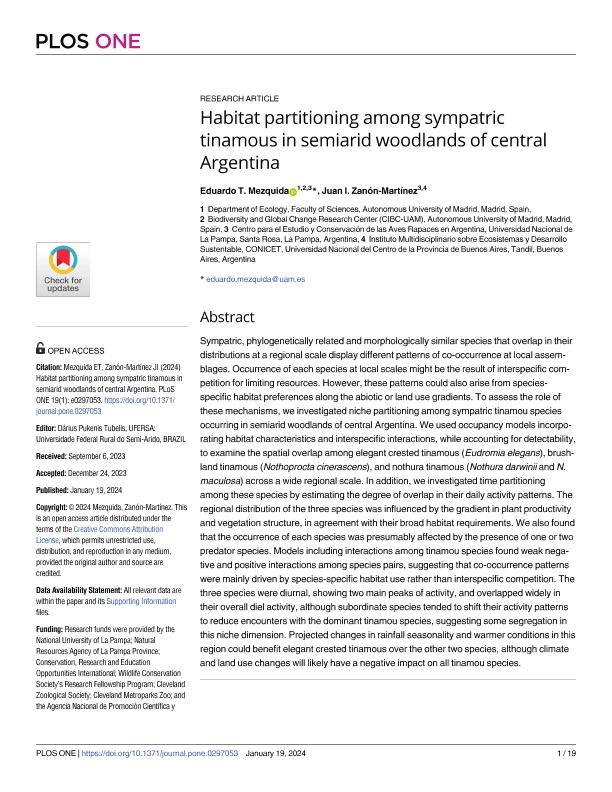Mostrar el registro sencillo del ítem
dc.contributor.author
Mezquida, Eduardo T.
dc.contributor.author
Zanón Martínez, Juan Ignacio

dc.date.available
2024-03-22T11:30:43Z
dc.date.issued
2024-01
dc.identifier.citation
Mezquida, Eduardo T.; Zanón Martínez, Juan Ignacio; Habitat partitioning among sympatric tinamous in semiarid woodlands of central Argentina; Public Library of Science; Plos One; 19; 1; 1-2024; 1-19
dc.identifier.issn
1932-6203
dc.identifier.uri
http://hdl.handle.net/11336/231280
dc.description.abstract
Sympatric, phylogenetically related and morphologically similar species that overlap in their distributions at a regional scale display different patterns of co-occurrence at local assemblages. Occurrence of each species at local scales might be the result of interspecific competition for limiting resources. However, these patterns could also arise from species-specific habitat preferences along the abiotic or land use gradients. To assess the role of these mechanisms, we investigated niche partitioning among sympatric tinamou species occurring in semiarid woodlands of central Argentina. We used occupancy models incorporating habitat characteristics and interspecific interactions, while accounting for detectability, to examine the spatial overlap among elegant crested tinamous (Eudromia elegans), brushland tinamous (Nothoprocta cinerascens), and nothura tinamous (Nothura darwinii and N. maculosa) across a wide regional scale. In addition, we investigated time partitioning among these species by estimating the degree of overlap in their daily activity patterns. The regional distribution of the three species was influenced by the gradient in plant productivity and vegetation structure, in agreement with their broad habitat requirements. We also found that the occurrence of each species was presumably affected by the presence of one or two predator species. Models including interactions among tinamou species found weak negative and positive interactions among species pairs, suggesting that co-occurrence patterns were mainly driven by species-specific habitat use rather than interspecific competition. The three species were diurnal, showing two main peaks of activity, and overlapped widely in their overall diel activity, although subordinate species tended to shift their activity patterns to reduce encounters with the dominant tinamou species, suggesting some segregation in this niche dimension. Projected changes in rainfall seasonality and warmer conditions in this region could benefit elegant crested tinamous over the other two species, although climate and land use changes will likely have a negative impact on all tinamou species.
dc.format
application/pdf
dc.language.iso
eng
dc.publisher
Public Library of Science

dc.rights
info:eu-repo/semantics/openAccess
dc.rights.uri
https://creativecommons.org/licenses/by-nc-sa/2.5/ar/
dc.subject
Eudromia elegans
dc.subject
Nothoprocta cinerascens
dc.subject
Nothura darwinii
dc.subject
Nothura maculosa
dc.subject
Habitat partitioning
dc.subject.classification
Ecología

dc.subject.classification
Ciencias Biológicas

dc.subject.classification
CIENCIAS NATURALES Y EXACTAS

dc.title
Habitat partitioning among sympatric tinamous in semiarid woodlands of central Argentina
dc.type
info:eu-repo/semantics/article
dc.type
info:ar-repo/semantics/artículo
dc.type
info:eu-repo/semantics/publishedVersion
dc.date.updated
2024-03-19T14:23:55Z
dc.journal.volume
19
dc.journal.number
1
dc.journal.pagination
1-19
dc.journal.pais
Estados Unidos

dc.description.fil
Fil: Mezquida, Eduardo T.. Universidad Autónoma de Madrid; España
dc.description.fil
Fil: Zanón Martínez, Juan Ignacio. Universidad Nacional del Centro de la Provincia de Buenos Aires. Facultad de Ciencias Exactas. Instituto Multidisciplinario de Ecosistemas y Desarrollo Sustentable; Argentina. Consejo Nacional de Investigaciones Científicas y Técnicas. Centro Científico Tecnológico Conicet - Tandil; Argentina
dc.journal.title
Plos One

dc.relation.alternativeid
info:eu-repo/semantics/altIdentifier/url/https://dx.plos.org/10.1371/journal.pone.0297053
dc.relation.alternativeid
info:eu-repo/semantics/altIdentifier/doi/http://dx.doi.org/10.1371/journal.pone.0297053
Archivos asociados
